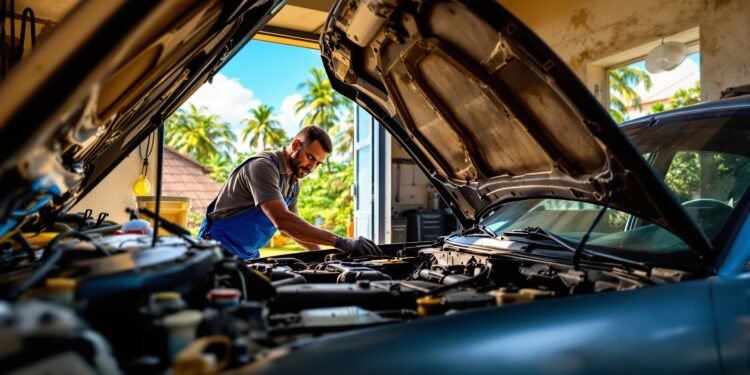Uganda’s tough driving conditions – unpaved roads, adulterated fuel, and a hot climate – lead to common car problems like suspension damage, engine wear, and overheating. Here’s a quick breakdown of the key challenges and solutions:
Key Challenges:
- Road Conditions: 80% of roads are unpaved, causing suspension wear.
- Fuel Quality: 25% of fuel tested in 2021 was adulterated, harming engines.
- Overheating: High temperatures and dusty roads strain cooling systems.
- Counterfeit Parts: 30-40% of spare parts are fake, leading to further damage.
- Limited Expertise: Only 35% of repair shops have certified mechanics.
Quick Solutions:
- Suspension Care: Drive slower, check tire pressure, and replace shocks every 80,000 km.
- Fuel Protection: Refuel at reputable stations, use quality filters, and clean fuel systems regularly.
- Prevent Overheating: Flush coolant every 30,000 km, clean radiators monthly, and inspect belts.
- Avoid Fake Parts: Buy from official dealerships or authorized retailers.
By following these tips, you can extend your car’s lifespan and reduce repair costs in Uganda’s challenging environment.
5 Common Causes of Engine Overheating: Prevention and Solutions
Road Conditions and Suspension Problems
With about 80% of Uganda’s roads remaining unpaved [1], vehicle suspensions endure constant strain from potholes and rough surfaces. This makes keeping your suspension in good shape a top priority for handling Uganda’s challenging roadways.
Signs of Suspension Damage
Watch for these common indicators that your suspension might need attention:
- Uneven tire wear, especially along the inner or outer edges
- Excessive bouncing after driving over bumps
- Vehicle pulling to one side while driving straight
- Nose diving during braking
- Unusual noises like knocking or clunking when hitting bumps
- Oil leaks on your shock absorbers [5]
Driving on Rough Roads
Uganda’s road conditions demand careful driving to protect your suspension. Use these techniques to minimize damage:
| Technique | Purpose | Impact |
|---|---|---|
| Reduce Speed | Lessens impact forces | Cuts shock absorber wear by up to 40% |
| Increase Following Distance | Gives time to avoid hazards | Prevents sudden maneuvers |
| Cross Speed Bumps at an Angle | Limits simultaneous wheel impact | Lowers suspension stress |
| Maintain Proper Tire Pressure | Boosts shock absorption | Extends suspension life by 15-20% |
"The poor state of roads in Uganda is a major contributor to vehicle damage and increased maintenance costs. Addressing suspension issues promptly can save drivers significant money in the long run." – John Muwanga, Automotive Engineer, Kampala Mechanics Association
Suspension Maintenance
Routine maintenance is key to keeping your suspension in peak condition:
- Monthly: Perform visual checks and monitor for any symptoms.
- Every 20,000 km/6 months: Get a professional alignment.
- Every 80,000 km: Replace shock absorbers.
Given the prevalence of counterfeit parts in Uganda [4], consider using these durable, verified components:
- Polyurethane bushings
- Reinforced control arms
- Skid plates to protect the undercarriage
- All-terrain tires for improved traction [6]
These steps will help ensure your suspension stays reliable, setting the stage for the next section on fuel quality solutions.
Fuel Quality Issues in Uganda
In 2022, about 5% of fuel samples tested by the Uganda National Bureau of Standards (UNBS) showed signs of tampering. This issue ties directly to Uganda’s automotive challenges – just as counterfeit parts harm suspension systems, adulterated fuel damages engines.
Effects of Poor Fuel Quality
Fuel adulteration, often involving kerosene, can cause serious engine problems. Here’s how different fuel types are impacted:
| Fuel Type | Common Adulterants | Effects on Engine |
|---|---|---|
| Petrol | Kerosene | Engine knocking, reduced power, increased wear |
| Diesel | Kerosene, Water | Injector damage, poor combustion, reduced efficiency |
"When kerosene is mixed with petrol, it results in higher emissions because they do not form a uniform mixture. This leads to an incomplete combustion, which will also cause engine wear, loss of power and dilution due to the high level of sulphur in kerosene." – Martin Imalingat, UNBS standards manager [2]
Identifying Bad Fuel
Be on the lookout for these warning signs of adulterated fuel:
- Fuel Efficiency Drop: A noticeable increase in fuel consumption by 20% or more.
- Engine Performance Issues: Rough idling, trouble starting, or unexpected power loss.
- Unusual Sounds: Knocking or pinging noises, especially during acceleration.
- Exhaust Changes: Abnormal smoke color or strong odors.
- Warning Lights: The check engine light turning on.
Fuel Quality Solutions
Vehicles running on adulterated fuel often face a 20-30% reduction in lifespan and 15-25% higher maintenance costs, according to research from the Uganda Automobile Association [1][3]. Here’s how to protect your vehicle:
| Prevention Strategy | How to Implement | Benefit |
|---|---|---|
| Choose Reputable Stations | Refuel at branded stations like Shell, Total, or Vivo | Minimizes risk of tampered fuel |
| Verify Quality | Look for UNBS quality seals | Ensures compliance with standards |
| Protect Fuel System | Use micron-rated fuel filters | Filters out contaminants |
| Regular Maintenance | Schedule professional fuel system cleaning | Prevents deposit buildup |
If you suspect you’ve purchased adulterated fuel:
1. Stop Driving: This prevents further engine damage, which could lead to costly repairs.
2. Get Professional Help: Have a certified mechanic clean and drain your fuel system.
3. Keep Records: Save receipts and store 100ml fuel samples in sealed containers for UNBS testing.
You can also use products like STP Fuel System Cleaner or Liqui Moly Diesel Purge to help counteract the effects of contaminated fuel. Tackling fuel quality issues now is critical to ensuring your vehicle is ready for Uganda’s next big challenge – managing engine temperatures in tropical conditions.
sbb-itb-7bab64a
Engine Overheating in Uganda’s Climate
Engine overheating is a common challenge for vehicles in Uganda. The combination of high temperatures, heavy traffic, and dusty roads creates a tough environment for cooling systems to function effectively. These factors make overheating a serious concern for drivers across the country.
Reasons for Overheating
Uganda’s climate and road conditions contribute to overheating in several ways:
| Factor | Impact |
|---|---|
| High Ambient Temperature | Makes it harder for the cooling system to dissipate heat. |
| Dust Accumulation | Clogs the radiator, reducing airflow. |
| Stop-and-go Traffic | Limits air circulation needed to cool the engine. |
| Poor Coolant Quality | Reduces the system’s ability to transfer heat efficiently. |
Preventing Overheating
Keeping your engine cool in Uganda requires regular maintenance that addresses these specific challenges:
| Maintenance Task | Frequency | Purpose |
|---|---|---|
| Coolant Flush | Every 30,000 km or 2 years | Prevents mineral deposits from reducing efficiency. |
| Radiator Cleaning | Monthly | Clears out dust and debris that block airflow. |
| Belt Inspection | Every 15,000 km | Ensures the water pump is functioning properly. |
| Thermostat Check | Annually | Keeps the engine operating at the right temperature. |
Staying on top of these tasks can help avoid overheating, but quick action is essential if the engine starts to overheat.
"In Uganda’s climate, engine overheating is not just an inconvenience – it’s a serious risk that can lead to costly engine damage. Regular maintenance and immediate action when overheating occurs are crucial." – Jane Akumu, Coordinator of Clean Fuels and Vehicles Programme at UNEP [4]
Emergency Response
If your engine temperature begins to climb dangerously, here’s what to do:
- Initial Response: Turn off the air conditioning and crank the heater to maximum. This pulls heat away from the engine. If you’re stuck in traffic, shift to neutral and keep the engine at a slightly higher idle to help coolant circulate [2].
- Safe Stop Procedure: Pull over as soon as it’s safe and shut off the engine. Wait at least 15 minutes before opening the hood to avoid burns from steam. Check for visible signs of steam or coolant leaks [3].
- Emergency Measures: Once the engine is completely cool, check the coolant level. If it’s low, top it off with the type recommended by the manufacturer [4].
Upgrades for Tough Conditions
For vehicles regularly exposed to Uganda’s demanding conditions, consider these enhancements:
- Install a high-flow radiator suited for tropical climates.
- Use synthetic heat-resistant oils for better performance.
- Add an auxiliary electric cooling fan to improve airflow in traffic.
- Equip your vehicle with an engine oil cooler for extra temperature control.
These upgrades, combined with regular maintenance, can make a big difference in keeping your engine running smoothly in Uganda’s challenging environment.
Finding Reliable Spare Parts
Just like good fuel keeps your engine running smoothly, using authentic spare parts is key to your vehicle’s longevity. With an estimated 30-40% of parts being counterfeit [4], verifying authenticity is a must.
How to Spot Authentic Parts
Counterfeit parts can be tricky to identify, but paying attention to details can help:
| Feature | Genuine Signs | Fake Clues |
|---|---|---|
| Packaging | Holographic seals, clear manufacturer logos | Blurry printing, spelling mistakes |
| Part Markings | Embossed details, proper serial numbers | Missing or inconsistent information |
| Material Quality | Consistent weight and smooth finish | Lightweight, rough edges |
| Price Point | Reasonable market pricing | Prices that seem too good to be true |
"The proliferation of counterfeit spare parts in Uganda is not just an economic issue, but a serious safety concern for all road users." – Eng. Daniel Arop, Executive Director, Uganda National Bureau of Standards, Annual Report 2023.
Where to Buy Trusted Spare Parts
There are several reliable sources in Uganda’s automotive market that are known for providing authentic parts:
| Dealer Type | Examples | Specialization |
|---|---|---|
| Official Dealerships | Toyota Uganda, Victoria Motors | Genuine brand-specific parts |
| Authorized Retailers | Spares Uganda, Motor Care Uganda | Multi-brand components |
| Specialized Suppliers | Japan Auto Parts, Yuasa Investments | Japanese cars, batteries |
For critical parts like brakes or steering components, buying from these trusted sources is especially important.
Finding Rare Parts
Need a hard-to-find part? These strategies can help:
1. Cross-Border Sourcing
Check dealers in Kenya or Tanzania, but factor in transportation costs.
2. Direct Manufacturer Orders
Authorized dealers can help you place direct orders with manufacturers, though this might take 4-6 weeks.
3. Professional Sourcing Services
Companies like AutoMag.ug have networks of verified suppliers, which can help you navigate Uganda’s limited technical resources.
Getting genuine spare parts is essential for tackling Uganda’s tough driving conditions, from bumpy roads to intense tropical heat.
Conclusion: Maintaining Vehicles in Uganda
Keeping vehicles in good condition in Uganda requires careful planning due to local challenges. A 2023 survey by AutoMag.ug found that vehicles receiving regular maintenance have 40% fewer breakdowns and last 25% longer than those that are neglected.
Uganda’s rough roads and issues like counterfeit parts make consistent upkeep essential for reliability. Regular maintenance tackles problems like overheating and suspension damage while minimizing the risk of unexpected breakdowns.
"Regular maintenance is not just about keeping your car running; in Uganda, it’s about ensuring your safety on challenging roads and maximizing your vehicle’s lifespan in a demanding environment", says John Mugisha, Head Mechanic at AutoCare Uganda.
According to the Uganda Automobile Association, drivers who stick to maintenance schedules save about 30% on total vehicle costs over five years compared to those who only fix issues as they arise.
For reliable maintenance tips, check out:
- AutoMag.ug’s detailed guides
- Certified mechanic networks
- Manufacturer-recommended schedules
In Uganda’s demanding driving conditions, staying proactive with maintenance saves money and ensures your vehicle stays safe, reliable, and road-ready.
Related Blog Posts
- 8 Essential Car Maintenance Tips for Uganda’s Climate
- 5 Most Reliable Family Cars Under $10,000 in Uganda
- Uganda’s Localization Policies in Automotive Manufacturing
- Ultimate Guide to Car Financing in Uganda




